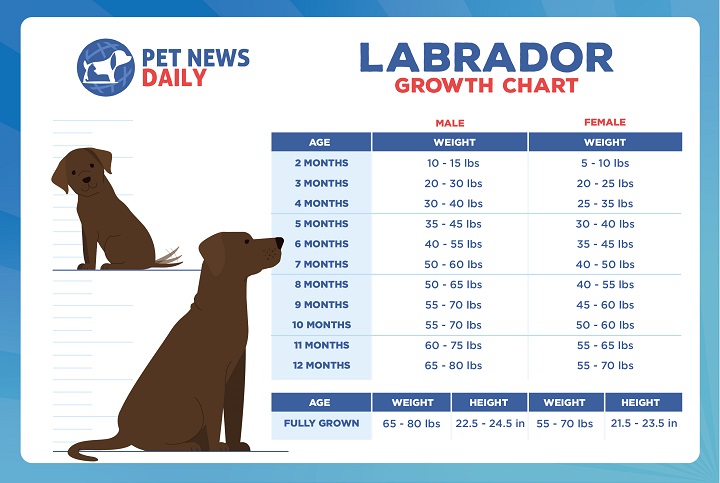By far the most popular dog breed, the Labrador Retriever has captured the hearts of Americans for decades. Maybe one has captured yours. Are you adopting or have you already gotten a Labrador puppy? Are you wondering how tall he’ll get? How much your Labrador Retriever will weigh? Our Labrador growth chart gives you an idea of a Labrador’s average weight at various life stages from puppyhood to adulthood. It’s important to keep in mind that puppies and adult dogs should be lean and fit, and these numbers are just a range for what’s considered average. Consult with your veterinarian about your puppy’s appropriate height and weight for her particular body type.
The Labrador Retriever is a great family dog and is considered a medium- to large-size breed. We consulted our veterinarian, Dr. Jennifer Coates, about the typical size and weight of Labradors at various ages. Based on data that Dr. Coates reviewed and approved, we created a convenient Labrador growth chart to help you determine how big your Lab may get as he grows. Check out our Labrador weight chart, by age, which shows you how fast lab puppies grow. Alternatively, use the Lab dog weight estimator – a handy tool that allows you to input your puppy’s breed, current weight, birth date, and gender to determine approximately how big your puppy will get.
In This Article
Labrador Retriever Growth Chart
Share This Labrador Growth Chart on Your Site
Text Transcript of the Labrador Retriever Growth Chart
| Labrador Retriever – Age | Male Weight | Female Weight |
|---|---|---|
| 2 months old 3 months old 4 months old 5 months old 6 months old 7 months old 8 months old 9 months old 10 months old 11 months old 12 months old Fully grown |
10 – 15 lbs 20 – 30 lbs 30 – 40 lbs 35 – 45 lbs 40 – 55 lbs 50 – 60 lbs 50 – 65 lbs 55 – 70 lbs 55 – 70 lbs 60 – 75 lbs 65 – 80 lbs 65 – 80 lbs |
5 – 10 lbs 20 – 25 lbs 25 – 35 lbs 30 – 40 lbs 35 – 45 lbs 40 – 50 lbs 40 – 55 lbs 45 – 60 lbs 50 – 60 lbs 55 – 65 lbs 55 – 70 lbs 55 – 70 lbs |
Whether your Labrador Retriever puppy is on his way or already curled up in your lap, you want to be a good pet parent. The Labrador Retriever puppy weight chart gives you an approximation for an 8-week-old Lab puppy’s size up to the size of an adult Lab. The chart differentiates between males and females and includes a fully grown Labrador’s height, measured at the shoulders.
The Lab puppy weight chart shows you the average weight for male and female Labs every month from 2 months old, up until 12 months (if you have a puppy Lab, check out our New Puppy Checklist to learn more about what to bring home for your first 24 hours and beyond). For instance, a 4-month-old Lab puppy’s weight is about 30 to 40 pounds for a male and 25 to 35 pounds for a female. This is about the halfway mark for a Labrador’s full size. Monitor your puppy’s growth to help you know if he’s hitting all the right targets. Doing so helps you and your veterinarian keep your puppy healthy.
Are There Different Sizes of Labradors?
The Labrador is one of six types of retrievers that the American Kennel Club, or AKC, classifies as part of the Sporting Group.1 Each retriever breed is different, coming in a variety of colors, coats, and sizes. Among the retriever breeds, the Labrador is one of the largest, where an adult male can top the scales at 80 pounds. In comparison, the smallest retriever breed is the Nova Scotia Duck Tolling Retriever, affectionately known as “The Toller,” who weighs about 30 pounds less at full size.2
The friendly, outgoing, and laid-back Labrador Retriever breed sports a few different coat colors – yellow, black, and brown (also referred to as chocolate), but are all about the same size in height and weight.3 Labrador Retriever puppies and young adults are naturally smaller than full-grown adults, and males tend to be larger than females.
Labrador Retrievers may differ in size due to individual variation and outside influences, such as the amount or type of food they eat, the amount or frequency of exercise they get, or underlying health conditions that may affect appetite or growth. But overall, a retriever should ideally hit a 5 out of 9 on the body condition score, regardless of the actual weight number on a scale. A healthy size Labrador has an evident abdominal tuck and observable waist, viewed from both the side and top of the dog.4
When Do Labs Stop Growing?
The AKC considers Lab puppies to be in adulthood when they reach 12 to 18 months of age, though there are outliers – those who grow faster or slower, reaching maturity either before 1 year old or not until 2 years old.5 Large dogs usually take longer to develop than smaller toy dogs, but Labrador Retriever puppies grow at roughly the same rate as other large dog breeds.
Like other large dog breeds, Labs go through multiple stages of puppyhood until they reach adulthood. Lab puppies gain about 10 to 15 pounds per month for the first few months, then about 5 pounds per month up until they’re fully grown, according to our lab puppy weight chart. The average height for Labrador puppies is largely unknown due to insufficient data, but the average adult Labrador Retriever gets to be about 22-24 inches tall at the shoulder.
The AKC, based on its breed-standard measurements and averages, estimates that large dog breeds, such as Labs, reach 60 percent of their full growth by the time they’re six months old.6 The majority of Labradors are about 85 percent fully grown when they celebrate their first birthday, and the average Lab stops growing at roughly 18 months. These numbers are contingent on the puppy receiving top-notch care, good nutrition, and appropriate levels of exercise.
How Do I Know How Big My Labrador Will Get?
Accurately predicting your new Lab puppy’s full-grown size is not a sure bet, though referring to our Labrador size and weight chart or the official breed standards set by the AKC can give you an estimate. Different factors, such as health, breeding practices, and nutrition, may alter these estimated numbers.
Most veterinarians monitor a puppy’s growth by their weight, age, and body condition score, so they’re the best source of information regarding whether your dog is at a healthy weight (which you can get a better sense of using our dog weight chart by age and breed).
Labrador Puppy Size and Weight Predictor
How big do Labs get fully grown? The below Labrador weight calculator can help you determine approximately how big your Labrador will be. But there are dogs who will fall outside of these parameters. The Waltham Petcare Science Institute offers puppy growth charts for veterinarians to use with their clients. Unlike the AKC’s use of breed-standard weights and height, Waltham uses data from 50,000 healthy young dogs to determine a healthy weight range based on age. If you want to monitor your puppy’s growth along the way, work with your veterinarian to use these charts to track your Lab puppy’s growth spurts.
The calculations for the puppy weight calculator are based on the American Kennel Club’s database of adult dog weights and heights. Fill in your puppy’s current age and weight details below.
You can also learn more about the ideal size and weight at different ages for different breeds with our Goldendoodle growth chart, a Golden Retriever size chart, Great Dane growth chart, or Chihuahua size chart.
Note: please don’t feed your dog more or less based on the results. For that advice, consult your veterinarian.
PUPPY WEIGHT CALCULATOR
Additional Resources
If you’re looking for more information about dog growth in general, we’ve created a series of growth charts for different breeds (and dogs and mixed breeds in general):
- Great Dane Growth Chart
- Goldendoodle Growth Chart
- Chihuahua Growth Chart
- Golden Retriever Growth Chart
- Labrador Growth Chart
- Dog Growth Chart
- Mixed Breed Growth Chart
- Rottweiler Growth Chart
- Pit Bull Growth Chart
- Australian Shepherd Growth Chart
- French Bulldog Growth Chart
- Great Pyrenees Growth Chart
- Standard Poodle Growth Chart
- Bernedoodle Growth Chart
- Husky Growth Chart
Article Sources
Pet News Daily uses only high-quality sources, including peer-reviewed studies, to support the facts within our articles. Read our editorial process to learn more about how we fact-check and keep our content accurate, reliable, and trustworthy.
- Paddock A. How Many Types of Retrievers Are There? Get to Know All Six Breeds. Akc.org. Published April 21, 2021. Accessed December 13, 2021.
- Nova Scotia Duck Tolling Retriever. Akc.org. Accessed December 16, 2021.
- Labrador Retriever. Akc.org. Accessed December 13, 2021.
- Body Condition Score. Wsava.org. Published 2013. Accessed December 16, 2021.
- Reisen J. A Puppy Growth Timeline: Transitions in Puppyhood. Akc.org. Published March 30, 2021. Accessed December 13, 2021.
- Paretts S. Puppy Growth Chart: When Does My Puppy Finish Growing? Akc.org. Published August 10, 2021. Accessed December 13, 2021.


